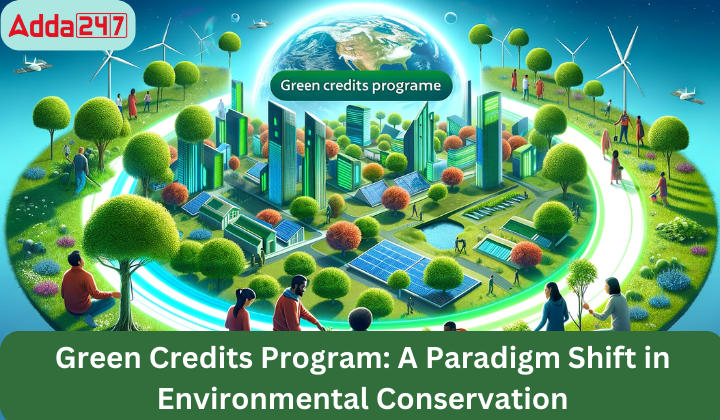Table of Contents
Green Credits Programme: The launch of the Green Credits Program by Prime Minister Narendra Modi at the 28th Conference of the Parties (COP28) heralds a new era in environmental conservation and sustainability. This groundbreaking initiative transcends the limitations of the traditional carbon credit system by embracing a holistic model that incentivizes a broader spectrum of positive environmental actions. This article explores the intricacies of the Green Credits Program, its potential impacts, and its distinction from the existing carbon credit system.
Genesis of the Green Credits Program
Background and Launch
The Green Credits Programme, formally unveiled by PM Modi at COP28, represents a visionary step towards global environmental sustainability.
It is an initiative that seeks to motivate not just industries and corporations, but also individuals and communities, to engage in actions beneficial to the environment.
Conceptual Framework
The program is founded on the principle of rewarding a wide array of environmental conservation efforts. Unlike carbon credits, which are limited to carbon emission reduction, green credits encompass activities such as water conservation, soil improvement, and biodiversity protection.
Carbon Credits: The Existing Paradigm
Carbon Credits: The Traditional Approach
Carbon credits, a cornerstone of current environmental policy, are tradable certificates representing the right to emit a certain amount of carbon dioxide or other greenhouse gases.
Companies or countries earn these credits by reducing their emissions below a certain threshold, which they can then sell to others who are struggling to meet their emissions targets.
Limitations of Carbon Credits
While effective in some ways, the carbon credit system has been critiqued for its narrow focus on carbon emissions, often overlooking other vital environmental aspects such as biodiversity and water conservation.
Green Credit Program: An Overview
Broadening the scope
The Green Credits Program extends beyond the realm of carbon emission reductions. It incorporates a wider range of environmental conservation activities, reflecting a more inclusive approach to environmental sustainability.
Mechanism of Action
The program operates by creating a market for green credits, similar to carbon credits. These credits are earned through various environmentally positive actions, the specifics of which are currently being developed.
Methodologies and standards
Establishing robust methodologies and standards for measuring and verifying diverse environmental actions is a crucial aspect of this program, ensuring credibility and effectiveness.
Differences between Green Credits and Carbon Credits
Comparative Analysis
While carbon credits focus solely on carbon emission reductions, green credits apply to a broader range of environmental conservation activities, offering a more comprehensive approach to sustainability.
Impact Spectrum
The Green Credits Program is designed to benefit a wider spectrum of stakeholders, including individuals, communities, and industries, fostering a more inclusive environmental conservation effort.
Potential Implications of the Green Credits Programme
For the Environment
The environmental benefits of the Green Credits Program are extensive, ranging from enhanced biodiversity to improved soil and water quality.
For industries and corporations
Industries can leverage green credits to fulfill their environmental responsibilities, potentially transcending the limitations imposed by the carbon credit system.
For communities and individuals
This program opens up new avenues for communities and individuals to contribute to environmental conservation and benefit from their efforts.
Challenges and Limitations
Developing the Market
Establishing a robust market for green credit is a significant challenge, necessitating broad acceptance and effective market mechanisms.
Verification and monitoring
Ensuring accurate measurement and verification of diverse environmental actions is complex but essential for the program’s credibility and success.
International Acceptance and Integration
Gaining international acceptance and integrating the program with existing environmental conservation frameworks remains a key challenge.
Role of Green Credits in Corporate Social Responsibility (CSR)
Green Credits and CSR
The program aligns well with CSR initiatives, providing companies with new opportunities to demonstrate their commitment to environmental stewardship.
Case Studies and Examples
Examples of how green credits could enhance CSR efforts include projects in water conservation, afforestation, and biodiversity conservation.
Global Implications and the Role of COP28
At COP28, PM Modi’s proposal to introduce the Green Credits Programme to the international community was a strategic move to establish a global market for these credits.
This initiative mirrors the international carbon credit market, aiming to create a similarly impactful global system for green credits.
Future of Green Credits
International Collaboration and Expansion
According to PM Modi’s vision, there is a significant chance that the Green Credits Program will catch on internationally and promote international environmental cooperation.
Innovation and Technology in Green Credits
Technological advancements are expected to play a crucial role in measuring, verifying, and trading green credits.
Predictions and scenarios
The future trajectory of the Green Credits Program could see it becoming a key component of global environmental policy, driving innovation and cooperation in sustainability.
Conclusion
The Green Credits Program represents a transformative shift in environmental conservation, extending the scope of incentives beyond carbon emissions to a more inclusive and comprehensive approach to ecological preservation. Its success hinges on global acceptance, effective implementation, and the continuous evolution of its mechanisms to address ever-changing environmental challenges.



 TSPSC Group 1 Question Paper 2024, Downl...
TSPSC Group 1 Question Paper 2024, Downl...
 TSPSC Group 1 Answer key 2024 Out, Downl...
TSPSC Group 1 Answer key 2024 Out, Downl...
 UPSC Prelims 2024 Question Paper, Downlo...
UPSC Prelims 2024 Question Paper, Downlo...




